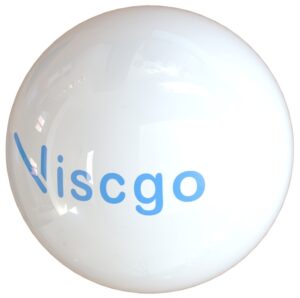Dysphagia, or difficulty swallowing, is a significant concern for individuals with neurological disorders or those recovering from a stroke. One therapeutic approach that has gained recognition for its effectiveness in dysphagia rehabilitation is the Chin Tuck Against Resistance (CTAR) exercise. This technique is designed to strengthen the suprahyoid muscles, which are critical for elevating the larynx during swallowing.
Viscgo Chin Tuck Against Resistance (CTAR) Ball

Evidence-based therapy tool to improve swallowing function
“CTAR exercise more selectively activates the suprahyoid muscle and is an effective therapeutic exercise for improving swallowing function in patients with dysphagia. Because it is less strenuous than Shaker exercise, it requires less physical burden and effort, allowing greater compliance.”1
Understanding Chin Tuck Against Resistance (CTAR)
The Chin Tuck Against Resistance (CTAR) exercise is specifically aimed at improving swallowing function by enhancing the strength of the muscles involved in this process. The exercise primarily targets the suprahyoid muscles, which play a crucial role in lifting the larynx during swallowing. The CTAR exercise involves the patient tucking their chin toward their chest while applying pressure against a resistance tool, such as an inflatable ball, positioned between the chin and chest.
Selecting the Appropriate Resistance for CTAR
To maximize the effectiveness of CTAR exercises, it is essential to choose the right level of resistance. Resistance can be modified based on physical abilities and therapeutic goals. Starting with a soft ball and gradually increasing resistance as strength improves is a common strategy. Consultation with a Speech and Language Therapist or other healthcare provider is advised to determine the most suitable resistance and progression plan.
The choice of resistance tool is also important. For example, the use of specialized balls designed for CTAR exercises can enhance both comfort and effectiveness. These tools are particularly beneficial for elderly patients or those with neck issues, ensuring that the exercise can be performed safely.
How to Perform CTAR Exercises
Here are the basic steps to perform CTAR exercises, though it’s important to consult with a healthcare professional to tailor the exercise to individual needs:
- Preparation: Sit comfortably.
- Positioning: Place the Viscgo CTAR ball between chin and chest.
- Chin Tuck: Tuck chin down towards chest, pressing the ball firmly.
- Apply Resistance: Press the ball consistently to create resistance. There are two key tasks in CTAR exercises:
- Isometric Task: Squeeze and hold the pressure for a designated time, typically 5-10 seconds.
- Isokinetic Task: Squeeze the ball repeatedly with full effort for a specific number of repetitions.
- Rest and Repeat: After each set, relax briefly before repeating the exercise. It is generally recommended to perform several sets of repetitions daily for optimal results.
“CTAR exercise is an effective therapeutic method for post-stroke dysphagia rehabilitation and is superior to Shaker exercise in improving swallowing safety with positive effect to patients' psychological condition.”2
Benefits of CTAR Exercises
CTAR exercises offer numerous benefits, particularly in enhancing laryngeal elevation and improving tongue pressure, both of which are crucial for effective swallowing. Strengthening these muscles leads to improved swallowing function, which is vital for patients recovering from conditions like stroke.
Research indicates that CTAR exercises are effective in improving swallow function in patients with dysphagia. Studies have shown that these exercises significantly enhance laryngeal elevation, increase tongue pressure, and improve overall swallowing ability when compared to traditional therapy methods.
Regular repetition of CTAR exercises helps reinforce the correct muscle activation patterns during swallowing. However, it is crucial to consult a healthcare professional before beginning any exercise program to ensure it is safe and appropriate for the individual’s condition. By targeting the suprahyoid muscles, CTAR exercises can play a significant role in restoring proper swallowing function in patients with dysphagia.
“Standard care with a multi-professional approach, involving one or two visits by an OT and a dietitian combined with a six-week intervention with CTAR, improved the swallowing function and the HRQoL the participants maintained their weight compared with a group receiving standard care only … Citizens who can continue training after completing municipal rehabilitation will receive a good effect from instruction in CTAR.”3
References
- Park JS, Hwang NK. Chin tuck against resistance exercise for dysphagia rehabilitation: A systematic review. J Oral Rehabil. 2021 Aug;48(8):968-977. doi: 10.1111/joor.13181. Epub 2021 Jun 12. PMID: 33973284. https://pubmed.ncbi.nlm.nih.gov/33973284
- Liu J, Wang Q, Tian J, Zhou W, Gao Y, Chen X, Zhang W, Gao Y, Zhou L. Effects of chin tuck against resistance exercise on post-stroke dysphagia rehabilitation: A systematic review and meta-analysis. Front Neurol. 2023 Jan 9;13:1109140. doi: 10.3389/fneur.2022.1109140. PMID: 36698882; PMCID: PMC9868925. https://www.ncbi.nlm.nih.gov/pmc/articles/PMC9868925
- Jensen D, Bendsen BB, Westmark S, Riis J, Krarup AL, Westergren A, Melgaard D. Effect of Chin Tuck against Resistance Exercise in Citizens with Oropharyngeal Dysphagia-A Randomised Controlled Study. Geriatrics (Basel). 2022 Nov 18;7(6):129. doi: 10.3390/geriatrics7060129. PMID: 36412618; PMCID: PMC9680398. https://pubmed.ncbi.nlm.nih.gov/36412618
